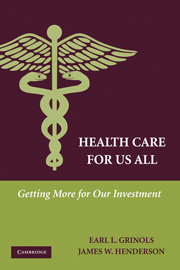Book contents
- Frontmatter
- Contents
- List of Tables
- List of Figures
- Preface
- Acknowledgments
- Executive Summary of the Targeted Intervention Plan
- PART I GOALS AND WORKING PRINCIPLES
- PART II BACKGROUND ECONOMICS AND ETHICS
- PART III APPLICATION
- PART IV PROTECTIVE MEASURES
- A Top Ten Goals for the American Health Care System
- B Badly Done Insurance Programs Can be Worse Than No Insurance
- C Incentive Symmetry and Intervention Principle
- D Plan Workability
- E Market Power Response to Insurance
- Glossary and Definitions
- References
- Index
B - Badly Done Insurance Programs Can be Worse Than No Insurance
Published online by Cambridge University Press: 05 June 2012
- Frontmatter
- Contents
- List of Tables
- List of Figures
- Preface
- Acknowledgments
- Executive Summary of the Targeted Intervention Plan
- PART I GOALS AND WORKING PRINCIPLES
- PART II BACKGROUND ECONOMICS AND ETHICS
- PART III APPLICATION
- PART IV PROTECTIVE MEASURES
- A Top Ten Goals for the American Health Care System
- B Badly Done Insurance Programs Can be Worse Than No Insurance
- C Incentive Symmetry and Intervention Principle
- D Plan Workability
- E Market Power Response to Insurance
- Glossary and Definitions
- References
- Index
Summary
A frequently encountered – but invalid – perspective on health care and health insurance is that if a well-designed framework is not adopted, then, at a minimum, insuring everyone through some government plan would be better than no insurance. This appendix provides an example demonstrating that this perspective is false.
There are four elements that interact to determine whether health insurance will improve the well-being of the insured:
risk aversion,
moral hazard,
handling costs, and
market power response to insured customers.
Each of these has been discussed in the text in Chapters 7, (Section 7.2, “Essential Insurance”) and 11. Here we provide a small equilibrium model incorporating all four elements that shows that it is possible for everyone to be worse off with insurance compared to the alternative where no one has it. In this example, it is the case that when everyone is insured, an individual is better off to buy insurance (showing that the insurance equilibrium is stable), even though all would be better uninsured. The reason is that being outside the insurance pool when prices have been made higher as a result of the presence of insurance makes it harder to pay for medical treatment. Before describing the model, we explain briefly the relevant factors.
Risk management through insurance is, in and of itself, welfare-enhancing to risk averse individuals. If being insured, however, induces an inefficiently large increase in the need for and usage of the insured product – in this case, health care – and/or coverage extends inappropriately to benefits that should not be part of the benefits package, then we can be in a position similar to the lunch club participants described in Chapter 3.
- Type
- Chapter
- Information
- Health Care for Us AllGetting More for Our Investment, pp. 225 - 230Publisher: Cambridge University PressPrint publication year: 2009



